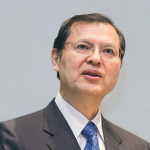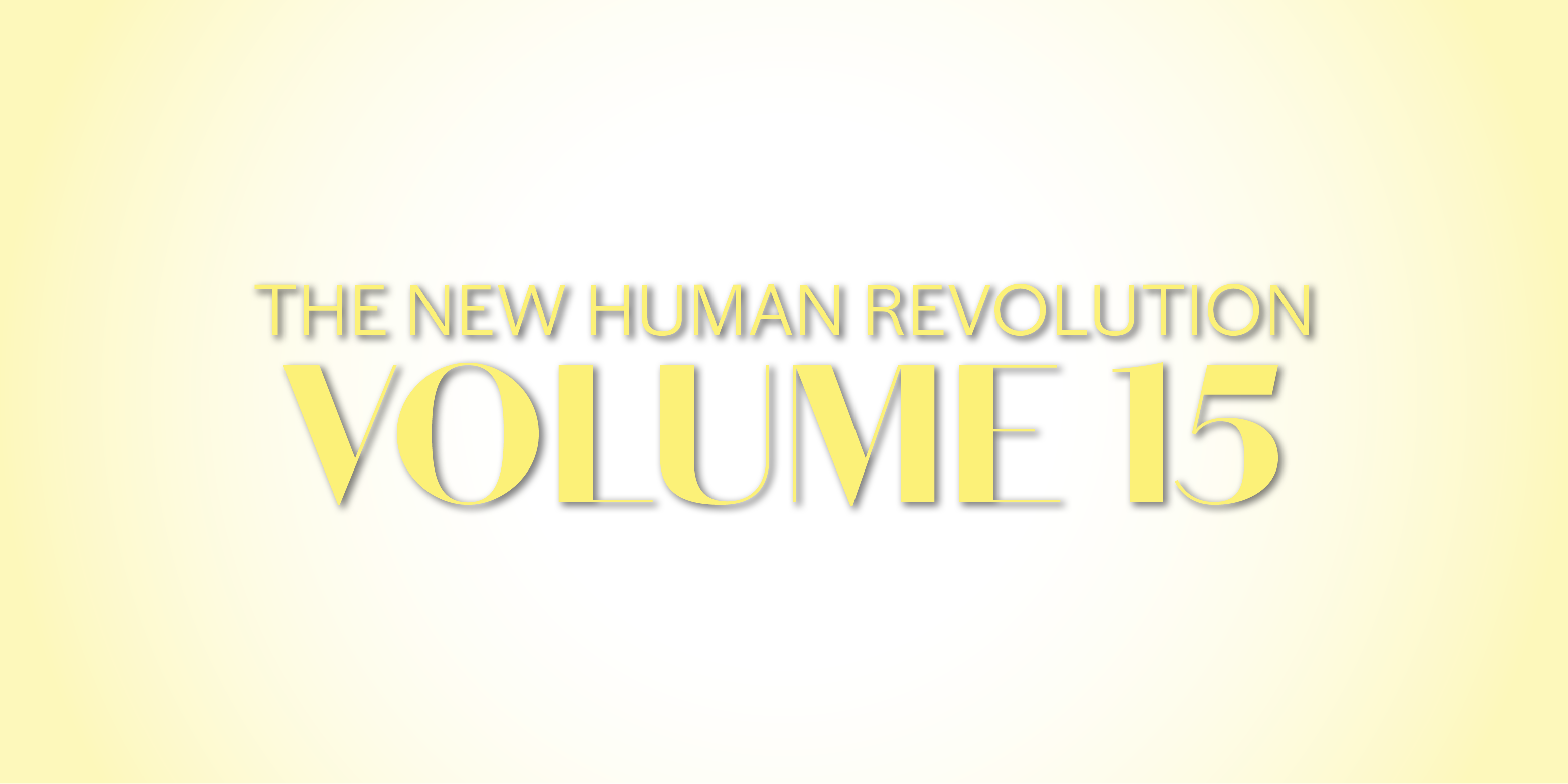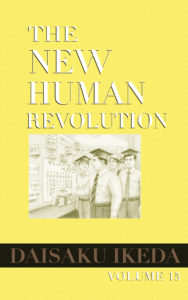 In the “Flowering” chapter of volume 15 of The New Human Revolution, SGI President Ikeda writes:
In the “Flowering” chapter of volume 15 of The New Human Revolution, SGI President Ikeda writes:
The most distinctive feature of Nichiren Buddhism is that it is a religion of kosen-rufu … Nichiren Buddhism is also a religion that seeks to “establish the correct teaching for the peace of the land.”[1]
“Establishing the correct teaching” is the act of instilling the philosophy of Buddhism in each person’s heart, by which we strive to realize “the peace of the land”—social peace and prosperity. If “establishing the correct teaching” is the religious mission of those who practice this Buddhism, then “the peace of the land” is our social mission; only when peace is realized in the land can we consider our religious mission to be complete.
The “Revitalization” chapter gives an account of the May 3, 1970, Soka Gakkai Headquarters General Meeting, at which Shin’ichi Yamamoto declares that kosen-rufu is “a great cultural movement unfolding on the vast spiritual earth of the Mystic Law.”[2] With Shin’ichi taking the lead, the Soka Gakkai has promoted a movement of “positively influencing society through the humanistic power of culture”[3] as a means of fulfilling its mission of bringing peace to the land.
The chapter goes on to detail how Shin’ichi begins to write poems and present them to members on various occasions as a form of encouragement. For Shin’ichi, poetry is a way of revealing “the great path to peace and happiness for all”[4] and offering a Buddhist perspective of the world and its natural environment. The “Flowering” chapter also describes how Shin’ichi makes the effort to take photographs while in Hokkaido as another way of encouraging, praising and inspiring the members whom he regards as the flag bearers—the protagonists—of a humanistic culture.
Yoshikazu Shirakawa, a renowned Japanese photographer, once commented that President Ikeda’s photos reflect a very pure and sincere wish to inspire as many people as possible to become happy. Indeed, his photos are filled with a desire to encourage others. The Seikyo Shimbun has regularly published photographs taken by President Ikeda along with excerpts from his poems and other written works. This is his way of encouraging fellow members: “Do not be defeated! Be strong! Advance with me!”[5]
Making Concrete Proposals
It is in the autumn of 1970 that the Soka Gakkai begins to earnestly engage in activities aimed at fostering a culture of genuine humanity in society. At that time, the Japanese people were engrossed by news about the pollution-related itai-itai and Minamata diseases that were afflicting parts of the country.
Shin’ichi sets about addressing the increasingly grave issue of pollution by contributing an essay titled “Is Japan a Pollution Laboratory?” in a leading Japanese monthly magazine. He also writes an essay on the subject for the autumn issue of the Soka Gakkai-affiliated Institute of Oriental Philosophy’s Toyo gakujutsu kenkyu (The Journal of Oriental Studies). In these articles, he discusses pollution from the perspective of how it relates to human society as a whole. They are considered unique because they trace the origins of the ways of thinking that have led to such environmental degradation and offer a clear direction toward a resolution.
In the “Vow” chapter of volume 30, Shin’ichi recalls how second Soka Gakkai President Josei Toda had emphasized the importance of making concrete proposals for the peace of humankind and then taking the lead in realizing them. He explained his reasons for this:
Even when such proposals are not fully or immediately accepted, they can serve as a “spark” from which a movement for peace will eventually spread like wildfire. Theorizing that is not grounded in reality will always remain a futile exercise. Concrete proposals provide a framework for the transformation of reality and can serve to protect the interests of humanity.[6]
President Ikeda’s articles on environmental pollution issues were a way of putting his mentor’s guidance into action. It is with this spirit that he has also been issuing peace proposals on January 26, SGI Day, every year since 1983.
In an effort to realize and implement President Ikeda’s ideas and visions for peace expressed in these proposals, the Soka Gakkai youth division in Japan recently launched an initiative called SOKA Global Action 2030. The year 2030 will mark the Soka Gakkai’s centennial; it is also the target year by which the United Nations aims to achieve its Sustainable Development Goals (SDGs). Toward this milestone, the SOKA Global Action 2030 program will engage in activities to expand global momentum for the abolition of nuclear weapons and the elimination of war, advance goodwill and friendship in Asia, and widely promote the SDGs.
In this year’s peace proposal, President Ikeda comments on this new initiative for peace led by the youth and expresses his profound expectations for them: “I am deeply confident that as long as there is solidarity among youth, there is no impasse we cannot surmount.”[7]
Young people hold the key to a brighter future. As President Ikeda writes: “When youth take action, the times begin to move in a new direction.”[8] Let us sincerely pray that the youth division are able to freely take action to their heart’s content.
Crystallization of the Mentor-Disciple Spirit
The “Soka University” chapter details the course of the university’s development from its opening until the graduation of its first class.
Today, the university’s main gate and central tower bear inscriptions of the Chinese characters for Soka University in the calligraphy of founding Soka Gakkai President Tsunesaburo Makiguchi. The establishment of a school system running to the university level was Makiguchi’s dream, a vision he articulated in his book Soka kyoikugaku taikei (The System of Value-Creating Pedagogy).
Having inherited this vision, it was in November 1950, amid the dire personal circum-stances of having just been forced to suspend his business operations, that President Toda shared with Shin’ichi his hopes of establishing a Soka University. Shin’ichi accepted his mentor’s cherished wish and engraved it deeply in his heart.
Soka University eventually opens on April 2, 1971—the year marking the 100th anniversary of President Makiguchi’s birth, and the date marking the anniversary of President Toda’s passing. The establishment of Soka University is indeed the “crystallization of the mentor-disciple spirit spanning three generations.”[9]
In a conversation with some of the students from the first class, he shares that just like him, they too are “the founders of Soka University.”[10] Firmly believing in the students, trusting that they will rise to the challenge of building the university with the same awareness and sense of responsibility as their founder, he deliberately refrains from making official visits. Indeed, out of respect for the university’s autonomy, Shin’ichi held back from attending its opening event and its first entrance ceremony despite his position as founder. It is not until the Soka University Festival in November, which becomes his first official visit to the campus, that the university’s ideal is revealed as a student-centered institution overflowing with the founder’s love for the students.
In addition, during his address at the first graduation ceremony, Shin’ichi refers to the Buddhist principle “the assembly at Eagle Peak has not yet dispersed,” explaining that, “though on one level we may part ways, we will always be together.”[11]
He then proposes that the graduating students “make a vow as Soka University alumni to live with the spirit that you will always remain connected in your hearts.”[12] Having engraved these words in their lives, the graduates of Soka University now play active roles in various fields of society throughout the world.
Soka University will celebrate its 50th anniversary next year. It has been selected as part of the Top Global University Project initiated by the Japanese Ministry of Education, Culture, Sport, Science and Technology; its efforts to actively engage in the SDGs have also been recognized and praised by academic journals, including Times Higher Education, a British publication.
In all these ways and more, the mission of Soka University continues to expand as it strives to forge a path for lasting peace by fostering outstanding individuals committed to making a positive contribution to society.
Translated from the January 29, 2020, issue of the Seikyo Shimbun, the Soka Gakkai’s daily newspaper.
Summary of Contents
Revitalization
Shin’ichi Yamamoto challenges problems arising from environmental pollution, such as the outbreak of mercury poisoning in the Minamata area, and encourages the afflicted. Culture festivals are held across Japan. Shin’ichi publishes a series of poems, including the “Song of Youth.”
Soka University
Soka University opens in April 1971. Shin’ichi takes part in various student festivals and unveils a path for humanistic education.
Flowering
Shin’ichi begins taking photos to encourage the members. Bonds of friendship are created in Kamakura and Misaki, Kanagawa Prefecture, through community events. Shin’ichi and local members support relief efforts for participants at the World Boy Scout Jamboree, which had been affected by a severe typhoon.
This book is available at https://bookstore.sgi-usa.org.
References
- The New Human Revolution, vol. 15, p. 253. ↩︎
- Ibid., p. 261. ↩︎
- Ibid., pp. 275–76. ↩︎
- Ibid., p. 57 ↩︎
- Ibid., p. 275. ↩︎
- May 11, 2018, World Tribune, insert, p. 4. ↩︎
- www.daisakuikeda.org/assets/files/peaceproposal2020.pdf. ↩︎
- The New Human Revolution, vol. 15, p. 56. ↩︎
- Ibid., p. 89. ↩︎
- Ibid., p. 114. ↩︎
- Ibid., p. 234. ↩︎
- Ibid. ↩︎
You are reading {{ meterCount }} of {{ meterMax }} free premium articles


